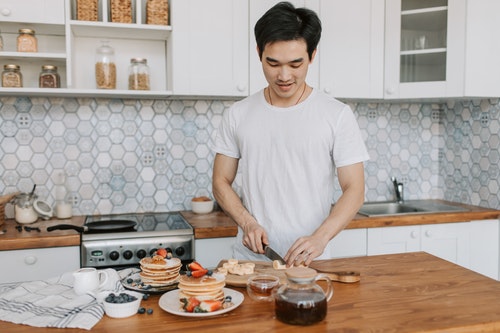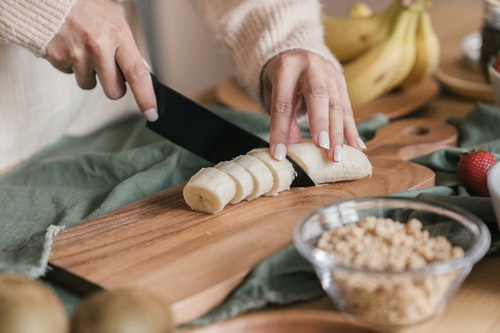Here are few safety precautions you need to know while sharpen kitchen knives. All of us are somehow guilty of our bad habits, and we don’t even know them, particularly when we are talking about cooking. It is not always simple to break bad habits, but being aware of these would be a smart first step toward adhering to knife safety standards when using sharp cooking knives. Knife mishaps are prevalent in home kitchens, but they can be minimized if good and safe habits are followed.
Rules for Knife SafetyIn Kitchen: Getting Rid of Bad Habits
Check out the followingrules and break the bad habitsby implementing them when cooking, cutting, or chopping. Follow the below-mentioned kitchen knife safety rules if you really are willing to really stay sharp, especially in the kitchen.
1. Avoid The Use OfDull Knives
Keeping your blades sharp is the most fundamental aspectof a kitchen knife’s safety. This appears to be paradoxical; after all, don’t you think a sharp and honed knife is way more dangerous? The risk of dull knives is in how they are used.
To achieve the similar cutting results to the one you get with the sharp knife, must apply more effort and may use the blade areas of the knife that are not designed for the work at hand and as soon as you search for a spot that is sharp enough just try to your cutting board. All of this additional energy and movement increases the likelihood that your knife’s blade will slide and cut anything else except food.
No matter if you escape getting injured, dull knives may pound their way, making it slide through the ingredients, creating extra work with minimized appealing outcomes. The simple solution? Maintain the sharpness of your knives!
2. Handle Knife Correctly
It is important to know how to use sharp knives as it is to maintain them sharply in the very first place. In the kitchen, there are mainly two knife grips. The most fundamental way is defined as handle grip, which is the same as it sounds: you grip your hand all around the blade’s handle.
Professional cooks and chefs prefer the second way; blade grip is also known as pinch grip because it provides far greater control. The second way(blade grip), you’re still holding the knife in the fist, your hand far enough on the knife’s handle that your thumb and the index finger pinch the knife’s blade somewhere at the handle’s base.
If you’ve ever witnessed an expert dicing and slicing through foods, you’ll notice the chef’s off-hand fingertips are curled under while they push all of the ingredients towards the knife. Practice, fittingly named “the claw,” it’s a simple approach to saving yourself from kitchen accidents by using your knuckles similar to a guide for the knife’s blade. This approach may feel odd initially, but it is critical to master.
3. Always Use a Handle To Pick The Knives
Even if the knife blade is dull, never touch it.
4. Choose The Appropriate Knife Size For The Work
For instance, when cutting a strawberry, use a little knife, such as a paring knife. If you’re slicing huge pieces of meat into smaller chunks, a larger, sharp blade is the way to go. It is critical to select a knife that feels more comfortable and controllable in your hand.
Always cut food away from your body and use a flat surface. Cutting ingredients away from your body reduces the risks of an accident.Food should be cut on a level surface (like a cutting board) so that it stays in one place. Do not cut ingredients while holding them in your hand. To avoid slipping off your knife and injuring you, keep it on the chopping board.

5. After Using Knives, Quickly Wash Them
Knives should not be soaked in soapy water with other dishes. When washing the knife blade, take caution and allow it to air dry. Knives should be stored safely while not in use. Knives must be protected in a shield or drawer where their blade would not rub against the other instruments, dulling or damaging them.
Most importantly, try to keep your knives out of the way of the kitchen traffic and small children’s reach.
6. Do Not Place Finger or Hand on the Knife’s Blade
Placing the index finger over the top of a knife’s blade is one of the typical mistakes, particularly if you haven’t learned the blade grip method for gripping your knife. Many individuals believe it will increase their control; however, it actually decreases there ability to control your knife.
If you’re utilizing a blade-grip approach, your index finger is importantfor keeping the blade in its place, so keep your knife folded back rather than lying along the rear of the knife’s blade. If you’re moving the finger to apply additional power down the knife’s length, you’re either using just the dull knife or maybe the wrong tool for the cutting job.
7. Always Wear a Cutting Glove.
Wearing a cutting glove will help you keep your hands safe from injuries or cuts.
8. Do Not Use Ceramic,Stone Cutting,or Glass Surfaces
While glass, stone, and ceramic boards make lovely presentation platters, they are not suitable for cutting. All of these surfaces are overly harsh and will dull your knives
9. Do Not Try To Catch a Falling Knife
You’d never play catch with a knife, would you? So why try to grab it if it’s falling off the counter? Resist the want to grab it, pause, step back, and pick up your knife after it falls on the floor.
The best way to incorporate all these knife safety habits is to start slowly, practice, and adhere to any and all safety rules that are mentioned. When you do, you will discover that using a knife is not only simple but enjoyable and risk-free too.


